Address any questions or comments regarding this newsletter to the individual authors listed after each article or to its editors, Nathan Johanning, 618-939-3434, njohann@illinois.edu or Bronwyn Aly 618-695-6060, baly@illinois.edu. The Illinois Fruit and Vegetable News is available on the web at: http://ipm.illinois.edu/ifvn/. To receive or be removed from email notification of new postings of this newsletter, contact Nathan Johanning or Bronwyn Aly at the phone numbers or email addresses above.
In This Issue:
Upcoming Programs (listings for beginning and established growers)
News & Announcements (Social Media Usage Research Study, National Farm to School Month)
Regional Reports (St. Louis Metro East, southern Illinois, Dixon Springs)
Fruit and Vegetable Pest Management (Purple Spot in Asparagus, New Grape Production Videos, Ripe & Ripening Blueberries Are Attracting Pests)
Upcoming Programs
See the University of Illinois Extension Local Food Systems and Small Farms Team’s website at:
http://web.extension.illinois.edu/smallfarm/ and the calendar of events at http://web.extension.illinois.edu/units/calendar.cfm?UnitID=629.
- Farm Tour - Bronkberry Farms, Wednesday, August 28, 2019, 9:00 A.M. to Noon, 18061 S. Bronk Road, Plainfield, Illinois 60586. The Farms grow vegetables and fruit including over 600 apple trees on 25+ acres. This season will be the first time apples will be produced. Chickens are also raised, and farm fresh eggs are sold. Read more about Bronkberry Farms here: https://bronkberryfarms.com/. The event is free, but please register online by August 26 at https://web.extension.illinois.edu/registration/?RegistrationID=20728. For more info, email James Theuri: jtheu50@illinois.edu or call 815-933-8337.
- On-Farm Readiness Review Field Days. August 28, 2019 PrairiErth Farm 2047 County Road 2100th Street, Atlanta, IL AND August 29, 2019 Flamm Orchards 8760 Old Highway 51 North Cobden, IL 9:00 a.m. to 2:30 p.m. with lunch provided. These workshops offer a chance to build a relationship with the FDA and see the FSMA: Produce Safety Rule in action on-farm to help you better prepare your operation for these requirements. This is a FREE workshop, but seating is limited. To register visit: www.ilfb.org/OnFarmReady. For any further information contact Raghela Scavuzzo at rscavuzzo@ilfb.org or 309)557-2155.
- Ogle County Farm Stroll, Sunday, September 8, 2019 from 12p.m.-5p.m. Free self-paced tours of diversified family farms. https://web.extension.illinois.edu/units/event.cfm?EventID=81661&UnitID=463
- Midwest Mechanical Weed Control Field Day, Wednesday September 18, 2019 from 8:30a.m.-4:30p.m. Learn the principles and tools for precise mechanical weed control from farmers and industry experts. Gwenyn Hill Farm W294 N130 Bryn Dr. Waukesha, WI 53188 https://thelandconnection.org/event/mechanicalweedcontrol2019/
- Guiding Farmers to Legal Resilience, Farm Common's workshop, Thursday September 19th, 2019 at the McLean County Farm Bureau Building in Bloomington. FREE full-day interactive farm law training workshop for agricultural service providers in Illinois. We invite you to join us for this day of farm law learning! For more info + to register, click here.
- Boone County Farm Stroll, Sunday, October 6, 2019 from 12 p.m.-5 p.m. Free self-paced tours of diversified family farms. https://web.extension.illinois.edu/units/event.cfm?EventID=81622&UnitID=463
- 2020 Illinois Specialty Crops Conference, January 8-10, 2020, Springfield, IL. Save the date!!!! https://www.specialtygrowers.org/2020-save-the-date . More information to follow later in the year but mark your calendars now and plan on attending the pre-conference workshops, conference programming, trade show, and annual association meetings!
News & Announcements
Social Media Usage Research Study
You are invited to participate in a research study on discovering specialty crop growers’ usage of social media in the state of Illinois. This study is conducted by Dr. Hao Feng, a full professor of Food Science and Human Nutrition from the University of Illinois at Urbana-Champaign, in partnership with Illinois Farmers Market Association and Illinois Specialty Growers Association. It is intended for farmers and farmers market managers. Please distribute to your network as well.This study will take approximately 3-5 minutes of your time. We look forward to sharing the results with you.
Click on the link for the survey (https://illinoisaces.co1.qualtrics.com/jfe/form/SV_6JZD7Q1q4QiAg8l)
Raghela Scavuzzo
Associate Director of Food Systems Development
Illinois Farm Bureau
Governmental Affairs & Commodities
p: (309)557-2155 m: (309)532-9674
a: 1701 Towanda Avenue Bloomington, IL 61702-2050
w: www.ilfb.org e: rscavuzzo@ilfb.org
Coming in October….. National Farm to School Month!
National Farm to School Month is right around the corner, and now is the time to start planning celebrations for your, farm, school and community! Every October, thousands of students, teachers, farmers, food producers, food enthusiasts and families celebrate the connections happening all over the country between children and local food. Join us!
Mark your calendars for a Central Illinois Farm to School Boot Camp on October 15 at Parkland College in Champaign, IL. In addition to training for K -12 and early childhood food service personnel, administrators and garden managers, we will have a “Meet the Farmer” gathering at a local farm in the afternoon. More details coming soon, watch our homepage for a registration link and more information.
Here are other ways you can get involved:
- Check out the Illinois Farm to School page here
- Register for the Great Lakes Great Apple Crunch
- Sign up for the FREE Harvest of the Month program
- Find activity suggestions in the National Farm to School Month Celebration Toolkit
- Plan a farm to school site visit for your legislators
- Add your event to our National Farm to School Month event calendar
- Ask your governor or mayor to sign a Farm to School Month proclamation
- Download and print posters, stickers, coloring pages and bookmarks
- Recognize your local farm to school champions with an award
- Sign on your organization or school to be a National Farm to School Month outreach partner and help us spread the word!
If you would like more information on how you might celebrate National Farm to School Month 2019 please contact me at mary@sevengenerationsahead.org.
Mary Hosier
Illinois Farm to School Network Coordinator
Seven Generations Ahead
1049 Lake Street, Suite 200
Oak Park, Illinois 60301
cell 217-621-1074
mary@sevengenerationsahead.org
www.sevengenerationsahead.org
Regional Reports

Gala apple. Photo: E. Wahle
From the St. Louis Metro East… The region is wet again, with some areas having received 9+” since the last newsletter. Humidity has been exceptionally high, making the slightest task outdoors arduous. Heavy dew remains on plant surfaces well into the morning regardless of temperature. Forecast suggest cooler nights, which will favor red development in apple. It also gives some relief to workers.
The fall apple season has begun. Gala is in harvest, with Honeycrisp soon to follow. Peach harvest is fully into Cresthaven. Chester blackberries are mostly finished, with remaining berries having taken on a late-season bitterness. Plasticulture strawberries have been planted, starting off with several good rains.
The pumpkin crop looks good. Sweet corn, tomatoes and peppers (field and high tunnel) are still in harvest, but starting to slow down.
Elizabeth Wahle (618-344-4230; wahle@illinois.edu)
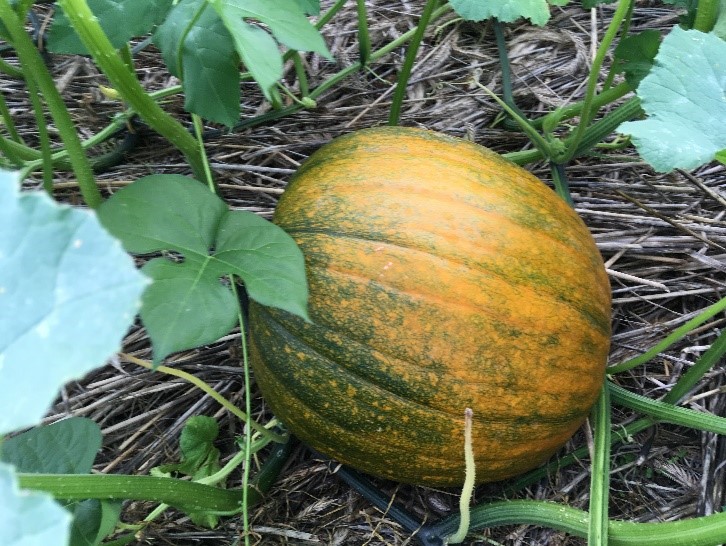
First pumpkin fruit starting to ripen on Jack O’Lantern pumpkins. Photo: N. Johanning
From southern Illinois... We finally have a little break from the intense humidity and heat with highs around 80˚ and partily cloudy conditions the last few days. Many places have seen at least some rain over the last week or so, alleviating the very dry conditions we have had. Late last week here at my office in Murphysboro we had 1.8” one evening while at my house 7 miles away we had 0.2”. At our family farm in Monroe County it is still very dry barely having 0.1” across the whole week. So some areas don’t want rain and others can’t get it. We have some more chances for rain in the early part of the week and with continued mild temperatures in the forecast.
Out in the orchard, we are into the late peaches with many orchards wrapping up with varieties like Fayette and PF 25 and some with later varieties still to come. Apple harvest has begun with Gala and some of the early goldens like Golden Supreme.
Pumpkins are doing well. Fruit set on most varieties has been good and a few early fruits are starting to color. Some reports of powdery mildew and some bacterial spot but overall most are doing well with a good spray program. For those that didn’t catch it earlier you can find the link to our pathologist, Dr. Babadoost’s Pumpkin Fungicide Recommendations for this season, at https://web.extension.illinois.edu/smallfarm/downloads/80257.pdf For those who are on the wet side be very vigilant for bacterial spot on leaves and fruit. It seems to come in quickly after heavy rains this time of year. For more information to help identify bacterial spot refer to the Report on plant Disease on this topic at http://extension.cropsciences.illinois.edu/fruitveg/pdfs/949_bacterial_spot.pdf. In my mind now is the critical time to maintain healthy vines. If disease hits now, it can greatly reduce fruit quality later in the season. If you can keep the disease under control the next few weeks it can go a long way to having a healthy crop through the harvest season.
Nathan Johanning (618-939-3434; njohann@illinois.edu)
From Dixon Springs Ag Center…Like most others, we have been experiencing hot and extremely humid conditions for the past couple of weeks. We did receive some needed rain last week and again through the weekend. We are continuing to harvest cucumbers, peppers, strawberries, and tomatoes each week, although tomato and pepper production is starting to slow down a bit. Last week saw mostly all green tomatoes but this week we will be back in the ripe tomato business. We are also continuing to fight flights of army worm, aphids, and spider mites.
The first research plots for our specialty crop block grant, “Utilizing High Tunnels to Maximize Winter Vegetable Production” were established on August 1st, with direct seeded carrot plantings. This is year one of two for this grant, with a focus on carrots, lettuce, spinach, and kale.

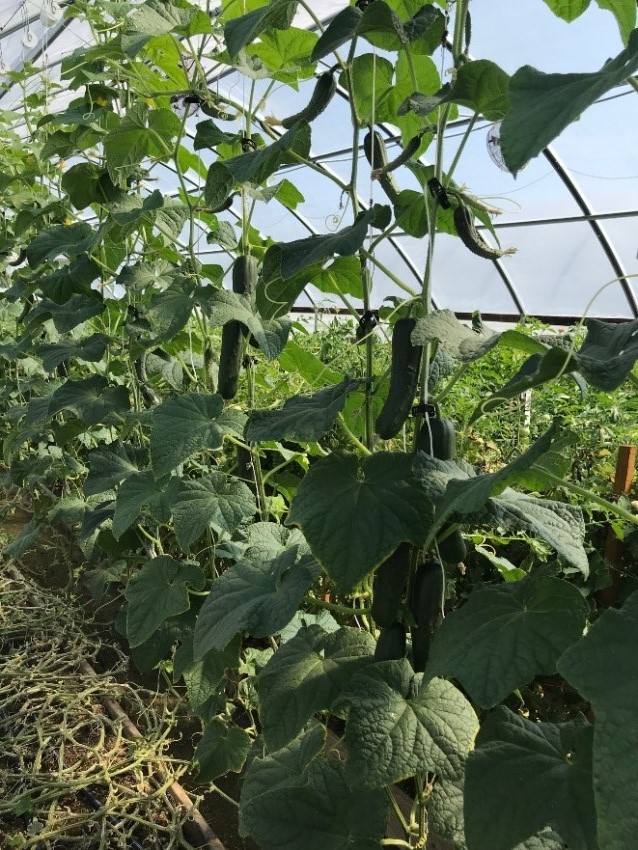
Moldy aphid honeydew residue on peppers; trellised cucumbers in high tunnel at DSAC. Photos by B. Aly.
When high populations of aphids exist on crops, they have the potential to spread viruses and impact overall plant health and fruit quality. The picture above (top left) shows an example of the “honeydew” from aphid feeding and the subsequent grayish-black moldy residue on the plant and fruit. While this residue is only on the surface of the fruit, it can be off putting to customers and very challenging to remove, often requiring a good scrubbing. See the link below for an article on aphid management in high tunnels written by Ric Bessin, University of Kentucky, Extension Entomologist https://kentuckypestnews.wordpress.com/2017/05/23/managing-aphids-in-high-tunnels-and-greenhouses/
Water management is a very important part of the overall production of crops for those growing in high tunnels. While we might think that we are delivering enough water to meet the needs of the various crops, the water demands can be higher than expected. As an example, a row of cucumbers within one of our high tunnels at DSAC was being watered (and fertigated at times) on a daily or every other day routine. The fruit set was okay but some of the fruit were hollow. Once we increased the amount of water being delivered, the fruit set increased and the number of hollow fruit diminished greatly. These plants were needing more water than we had been providing and yield suffered. Within a high tunnel, plants depend solely on the provided irrigation, as they have no way to access rainwater (exceptions being rain that may blow into the sides of the tunnel, but will really only reach the outermost beds inconsistently). Purchasing either a soil moisture meter or a tensiometer can help take the guesswork out of knowing how much water may be available to the plants. While soil moisture meters provide a measure of the moisture level in the soil, tensiometers give a measure of how strongly the water is held in the soil. These management tools run in the price range of $80-$200, depending on their individual features.
Bronwyn Aly (618-382-2662; baly@illinois.edu)
Fruit and Vegetable Pest Management
Purple Spot in Asparagus
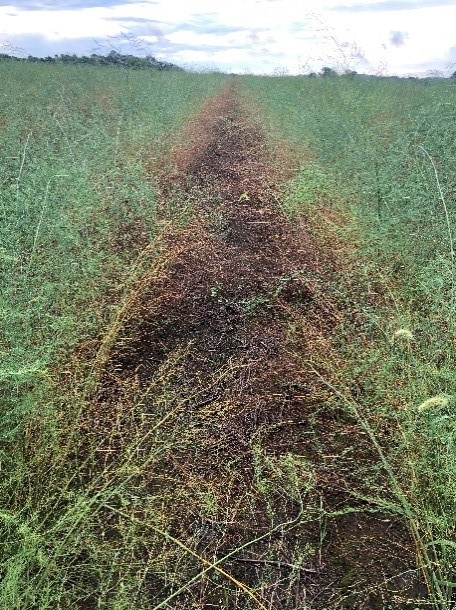
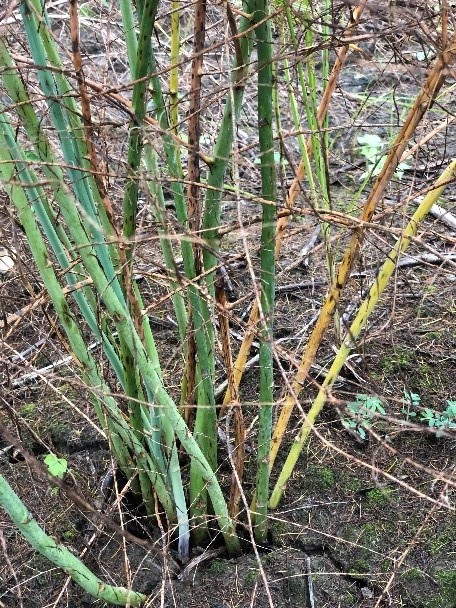
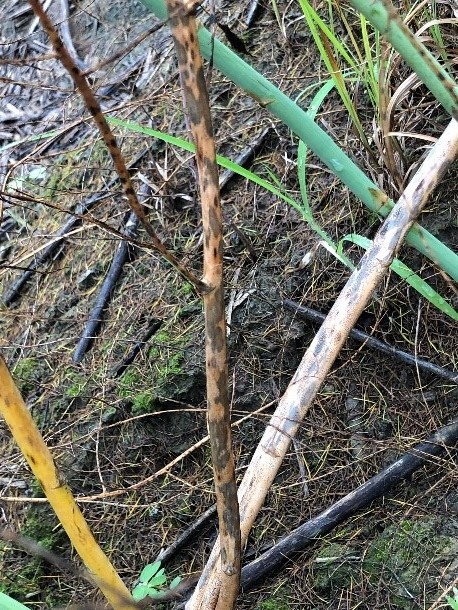
Purple spot is a soil-borne fungal disease affecting asparagus. It is especially problematic when provided favorable conditions like we had this past spring…extended cool and wet. It can easily be missed the first year of infection until this time of the year, when ferns start to prematurely defoliate. Upon closer inspection, numerous sunken, oval-shaped spots will be obvious on the senescing ferns in the case of purple spot, more prominently on the lower half of the fern. In the spring, these spots can also appear on emerging spears during harvest, then disappear just as quickly depending on weather conditions. This is a tough one to control once established, and somewhat a balancing act to manage. If purple spot defoliates the planting prematurely, it can reduce yield up to 50% the following spring. Cutting ferns before fully senesced, thinking to eliminate your problem, can have the same effect. At this time, growers with infected plantings should focus on fungicide applications to protect healthy ferns to keep the planting “green” for as long as possible. Note that products labelled for purple spot in Asparagus (Midwest Vegetable Production Guide for Commercial Growers https://ag.purdue.edu/btny/midwest-vegetable-guide/Pages/default.aspx) all have long PHIs (100-190 days), restricting their use to a limited post-harvest window. Sanitation is the other critical step. All infected material must to be removed and destroyed following cutting of the ferns. Do this as soon as ferns have fully senesced, but not before. Fungicide spray should begin after final harvest the following spring.
Elizabeth Wahle (618-344-4230; wahle@illinois.edu)
New Grape Production Videos
There are two new grape production videos posted covering some late season production and harvest management techniques
Exposing Grape Clusters to Sunlight without Sunburning https://youtu.be/8qrW1A5RG5g
Grapes require sunlight to ripen properly, but not so much that they sunburn. In this video Dr. Bradley Taylor and his students, Southern Illinois University-Carbondale, and Dr. Elizabeth Wahle, University of Illinois Extension, discuss and demonstrate methods of gently exposing fruit for maximum development of flavor characteristics, which also promotes undesirable conditions for bunch rot development. Recorded August 15, 2019 at the Grafton Winery, the Vineyards, Grafton, IL.
Pre-harvest Grape Berry Sampling https://youtu.be/JS4ex1EoYxE
Wine grapes enter veraison (onset of ripening) well before full development of the varietal flavor characteristics and should not be harvested on visual cues alone. In this video Dr. Bradley Taylor and his students, Southern Illinois University-Carbondale, and Dr. Elizabeth Wahle, University of Illinois Extension, discuss and demonstrate proper sampling techniques for measuring degrees brix (sugar content) as a method to estimate harvest timing. Recorded August 15, 2019 at the Grafton Winery, the Vineyards, Grafton, IL.
Ripe & Ripening Blueberries Are Attracting Pests
As the blueberry harvest winds down in northern Illinois, ripe unharvested berries are attracting insect pests. In Kankakee County, I observed larvae that were probably of blueberry maggot - BBM (Rhagoletis mendax) and spotted-wing drosophila - SWD (Drosophila suzuki) on yellow sticky traps in mid-August. The best prevention of infestation by both pests is to harvest ripe berries in a timely manner, before they become over-ripe.
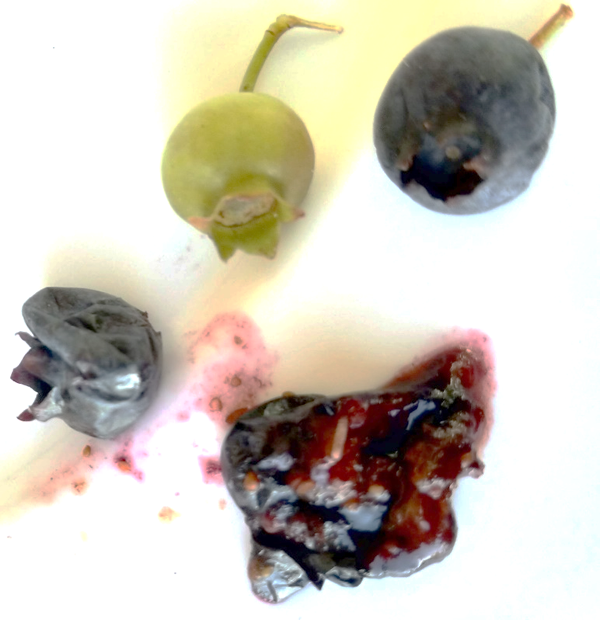
Some berries are still green while others are in various stages of ripening, as seen in picture (left). Approximately 25% of the berries had worm infestation. Both insect pests lay eggs on fruit – one per fruit by BBM, while SWD cuts open the fruit with her serrated ovipositor to lay several eggs.
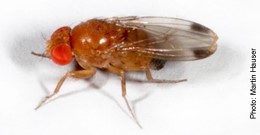
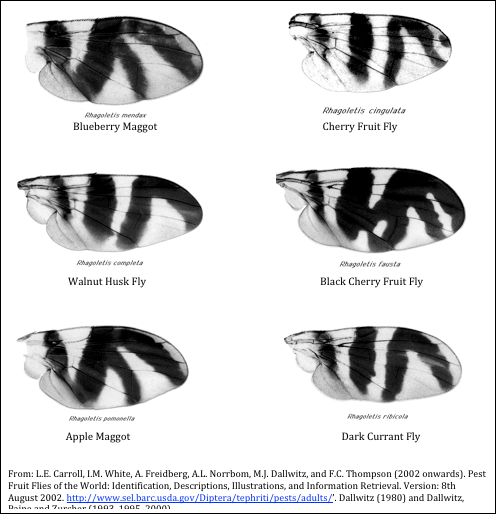
Proper identification of BBM is important – there are five other look-alike flies. The distinguishing feature is the M (or W) marks on the wing (see photo – BBM fly wing is on top right). On the other hand, SWD may look like other Drosophila fruit flies; their distinguishing feature is the two dark spots on the wings of male flies.
Monitoring both pests is critical, and as soon as just one is observed, protective measure should be taken.
For more information on SWD, see an excellent article in IFVN (Vol. 22, No. 7, May 4, 2016) here: https://ipm.illinois.edu/ifvn/contents.php?id=79 and for BBM, read here: https://www.lsuagcenter.com/topics/crops/fruits_and_vegetables/blueberries/pests/blueberry-maggot.
James Theuri (815-933-8337; jtheu50@illinois.edu)
Less Seriously
https://www.readersdigest.ca/culture/70-funniest-jokes-readers-digest/
- “Why do they lock gas station bathrooms? Are they afraid someone will clean them?” – George Carlin
- A guy spots a sign outside a house that reads “Talking Dog for Sale.” Intrigued, he walks in.
“So what have you done with your life?” he asks the dog.
“I’ve led a very full life,” says the dog. “I lived in the Alps rescuing avalanche victims. Then I served my country in Iraq. And now I spend my days reading to the residents of a retirement home.”
The guy is flabbergasted. He asks the dog’s owner, “Why on Earth would you want to get rid of an incredible dog like that?”
The owner says, “Because he’s a liar! He never did any of that!”
- The doctor says, “Larry, everything looks great. How are you doing mentally and emotionally? Are you at peace with God?”
Larry replies, “God and I are tight. He knows I have poor eyesight, so He’s fixed it so when I get up in the middle of the night to go to the bathroom, poof! The light goes on. When I’m done, poof! The light goes off.”
“Wow, that’s incredible,” the doctor says.
A little later in the day, the doctor calls Larry’s wife.
“Bonnie,” he says, “Larry is doing fine! But I had to call you because I’m in awe of his relationship with God. Is it true that he gets up during the night, and poof, the light goes on in the bathroom, and when he’s done, poof, the light goes off?”
“Oh, no,” exclaims Bonnie. “He’s peeing in the refrigerator again!”
- “What I don’t like about office Christmas parties is looking for a job the next day.” –Phyllis Diller
University of Illinois Extension Specialists in Fruit and Vegetable Production & Pest Management
Extension Educators – Local Food Systems and Small Farms |
||
Bronwyn Aly, Gallatin, Hamilton, Hardin, Pope, Saline, and White counties |
618-382-2662 |
|
Katie Bell, Franklin, Jackson, Perry, Randolph, & Williamson counties |
618-687-1727 |
|
Sarah Farley, Lake & McHenry counties |
847-223-8627 |
|
Nick Frillman, Woodford, Livingston, & McLean counties |
309-663-8306 |
|
Laurie George, Bond, Clinton, Jefferson, Marion, & Washington counties |
618-548-1446 |
|
Zachary Grant, Cook County | 708-679-6889 | |
Doug Gucker, DeWitt, Macon, and Piatt counties |
217-877-6042 |
|
Erin Harper, Champaign, Ford, Iroquois, and Vermillion counties |
217-333-7672 |
|
Grace Margherio, Jackie Joyner-Kersee Center, St. Clair County |
217-244-3547 |
|
Grant McCarty, Jo Daviess, Stephenson, and Winnebago counties |
815-235-4125 |
|
Katie Parker, Adams, Brown, Hancock, Pike and Schuyler counties |
217-223-8380 |
|
Kathryn Pereira, Cook County |
773-233-2900 |
|
James Theuri, Grundy, Kankakee, and Will counties |
815-933-8337 |
|
Extension Educators – Horticulture |
||
Chris Enroth, Henderson, Knox, McDonough, and Warren counties |
309-837-3939 |
|
Richard Hentschel, DuPage, Kane, and Kendall counties |
630-584-6166 |
|
Andrew Holsinger, Christian, Jersey, Macoupin, & Montgomery counties |
217-532-3941 |
|
Extension Educators - Commercial Agriculture |
||
Elizabeth Wahle, Fruit & Vegetable Production |
618-344-4230 |
|
Nathan Johanning, Madison, Monroe & St. Clair counties |
618-939-3434 |
|
Campus-based Extension Specialists |
||
Kacie Athey, Entomology |
217-244-9916 |
|
Mohammad Babadoost, Plant Pathology |
217-333-1523 |
|